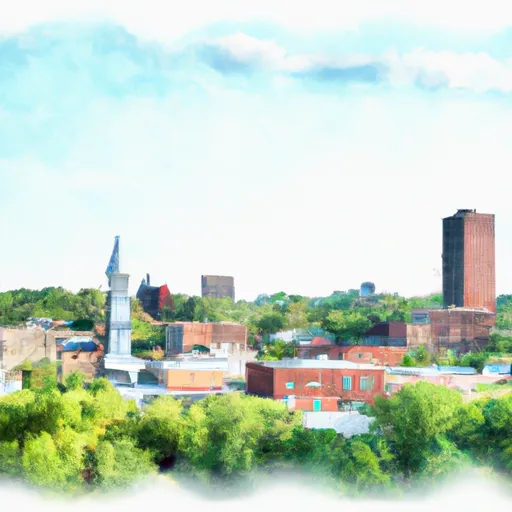-
 Snoflo Premium
Snoflo Premium
Get unlimited access to all our content
With no Ad interruptions! - Start Your Free Trial Login with existing account
New-Athens
Eden Index
Climate
8.3
•
Recreation
2.8
•
Community
3.8
•
Safeguard
5.2/10

New Athens, Illinois is a charming village located in St. Clair County, Southwest Illinois. The region experiences a humid continental climate, characterized by hot, humid summers and cold winters. Average temperatures range from 20°F (-6°C) in winter to 90°F (32°C) in summer, with moderate rainfall throughout the year.
The village is situated near the Kaskaskia River, which plays a significant role in the hydrology of the area. The river provides recreational opportunities like fishing, boating, and kayaking. Additionally, visitors can explore the nearby Marissa State Fish and Wildlife Area, which offers an abundance of wildlife and natural beauty.
Outdoor recreation enthusiasts can also enjoy the New Athens Community Park, featuring amenities such as picnic areas, ball fields, and walking trails. Furthermore, the Shawnee National Forest, a short drive away, allows for activities like hiking, camping, and hunting.
In summary, New Athens, Illinois offers a diverse range of outdoor recreation opportunities, including water-based activities, wildlife exploration, and access to nearby natural areas such as state parks and forests. The village's climate and hydrology constituents provide a conducive environment for engaging in various outdoor activities throughout the year.
What is the Eden Index?
The Snoflo Eden Index serves as a comprehensive rating system for regions, evaluating their desirability through a holistic assessment of climate health, outdoor recreation opportunities, and natural disaster risk, acknowledging the profound impact of these factors on livability and well-being.
Climate Health Indicator (CHI): 8.3
New-Athens receives approximately
1087mm of rain per year,
with humidity levels near 84%
and air temperatures averaging around
13°C.
New-Athens has a plant hardyness factor of
6, meaning
plants and agriculture in this region thrive during a short period during spring and early summer. Most
plants will die off during the colder winter months.
By considering the ideal temperature range, reliable water supplies, clean air, and stable seasonal rain or snowpacks, the Climate Health Indicator (CHI) underscores the significance of a healthy climate as the foundation for quality living.
A healthy climate is paramount for ensuring a high quality of life and livability in a region, fostering both physical well-being and environmental harmony. This can be characterized by ideal temperatures, reliable access to water supplies, clean air, and consistent seasonal rain or snowpacks.
Weather Forecast
Streamflow Conditions
Kaskaskia
Area Rivers
Kaskaskia
Snowpack Depths
Kaskaskia
Reservoir Storage Capacity
Kaskaskia
Groundwater Levels
Recreational Opportunity Index (ROI): 2.8
The Recreational Opportunity Index (ROI) recognizes the value of outdoor recreational options, such as parks, hiking trails, camping sites, and fishing spots, while acknowledging that climate plays a pivotal role in ensuring the comfort and consistency of these experiences.
Access to outdoor recreational opportunities, encompassing activities such as parks, hiking, camping, and fishing, is crucial for overall well-being, and the climate plays a pivotal role in enabling and enhancing these experiences, ensuring that individuals can engage in nature-based activities comfortably and consistently.
Camping Areas
| Campground | Campsites | Reservations | Toilets | Showers | Elevation |
|---|---|---|---|---|---|
| St. Bernard State Park | None | 3 ft | |||
| DLo Water Park | None | 312 ft | |||
| Okatoma Water Park | None | 396 ft | |||
| Atwood Water Park | None | 218 ft | |||
| Simpson County Lake | 11 | 427 ft | |||
| Fontainebleau State Park | None | 18 ft | |||
| Lake Columbia | 12 | 212 ft | |||
| New Orleans Reserve Military | None | 0 ft | |||
| Dry Creek Water Park | None | 514 ft | |||
| Walkiah Bluff Water Park | None | 38 ft |
Nearby Fishing
Nearby Ski Areas
Catastrophe Safeguard Index (CSI):
The Catastrophe Safeguard Index (CSI) recognizes that natural disaster risk, encompassing floods, fires, hurricanes, and tornadoes, can drastically affect safety and the overall appeal of an area.
The level of natural disaster risk in a region significantly affects safety and the overall livability, with climate change amplifying these risks by potentially increasing the frequency and intensity of events like floods, fires, hurricanes, and tornadoes, thereby posing substantial challenges to community resilience and well-being.
Community Resilience Indicator (CRI): 3.8
The Community Resilience Indicator (CRI) recognizes that education, healthcare, and socioeconomics are crucial to the well-being of a region. The CRI acknowledges the profound impact of these elements on residents' overall quality of life. By evaluating educational resources, healthcare accessibility, and economic inclusivity, the index captures the essential aspects that contribute to a thriving community, fostering resident satisfaction, equity, and social cohesion.

